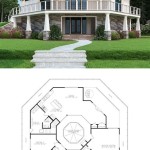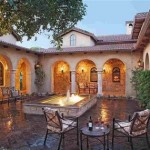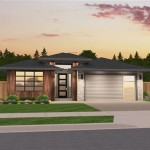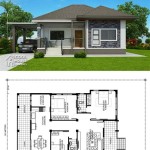Mid-century house floor plans refer to the designs and layouts of homes built during the mid-century modern period, typically encompassing the years between 1930 and 1970. These floor plans embodied a distinctive architectural style characterized by open and flowing spaces, an emphasis on indoor-outdoor connections, and an integration of modern materials and technologies. A notable example of a mid-century house floor plan is the famous Case Study House No. 22 designed by architect Pierre Koenig, showcasing a simple and efficient open-plan layout with large windows and a seamless connection to the outdoors.
Mid-century house floor plans were influenced by several factors, including the rise of the suburbs, the increasing affordability of automobiles, and the popularity of modern design. They were designed to meet the changing needs of post-war families, who sought homes that were both comfortable and stylish, and that reflected the forward-looking optimism of the era.
In this article, we will explore the key characteristics, design principles, and historical context of mid-century house floor plans, examining their enduring influence on modern residential architecture.
Here are 8 important points about mid-century house floor plans:
- Open and flowing spaces
- Indoor-outdoor connections
- Integration of modern materials
- Simple and efficient layouts
- Emphasis on natural light
- Use of sliding glass doors
- Atriums and courtyards
- Multi-level designs
These floor plans were designed to create comfortable and stylish homes that met the changing needs of post-war families.
Open and flowing spaces
Mid-century house floor plans are characterized by open and flowing spaces, which create a sense of spaciousness and allow for easy movement throughout the home. This design concept was a departure from the more traditional compartmentalized floor plans of the past, and it reflected the desire for a more modern andlifestyle.
- Elimination of unnecessary walls: Mid-century architects sought to create a sense of openness by eliminating unnecessary walls and partitions. This allowed for a more fluid and connected living space, where different areas flowed seamlessly into one another.
- Use of sliding glass doors: Sliding glass doors were a popular feature in mid-century homes, as they provided a way to connect the interior and exterior spaces. These doors could be opened up to create a seamless transition between the living room and the patio or backyard, blurring the boundaries between indoor and outdoor living.
- Integration of indoor and outdoor spaces: Mid-century architects also emphasized the integration of indoor and outdoor spaces. They often designed homes with large windows and glass walls that allowed for natural light to flood in and provided views of the surrounding landscape. Atriums and courtyards were also common features, creating private outdoor spaces that could be enjoyed from within the home.
- Multi-level designs: Some mid-century homes featured multi-level designs, which added visual interest and created a sense of separation between different areas of the home. Split-level homes, for example, often had a sunken living room or family room, which provided a cozy and intimate space for gathering.
The open and flowing spaces of mid-century house floor plans were designed to create a sense of freedom and flexibility, and to encourage a more casual and relaxed lifestyle.
Indoor-outdoor connections
Mid-century house floor plans emphasized the connection between indoor and outdoor spaces, creating homes that were open, airy, and connected to nature. This design concept was a reflection of the post-war desire for a more casual and relaxed lifestyle, and it continues to influence residential architecture today.
- Large windows and glass walls: Mid-century homes often featured large windows and glass walls that allowed for natural light to flood in and provided views of the surrounding landscape. These windows and glass walls helped to blur the boundaries between indoor and outdoor spaces, creating a sense of openness and connection to nature.
- Sliding glass doors: Sliding glass doors were another popular feature in mid-century homes, as they provided a way to connect the interior and exterior spaces. These doors could be opened up to create a seamless transition between the living room and the patio or backyard, allowing for easy indoor-outdoor living.
- Atriums and courtyards: Atriums and courtyards were also common features in mid-century homes, creating private outdoor spaces that could be enjoyed from within the home. Atriums were often located in the center of the home, providing natural light and ventilation to the surrounding rooms. Courtyards were typically located off of the living room or dining room, and provided a sheltered outdoor space for relaxing or entertaining.
- Multi-level designs: Some mid-century homes featured multi-level designs, which allowed for different areas of the home to have direct access to the outdoors. For example, a sunken living room might have a sliding glass door that leads out to a patio, or a master bedroom might have a private balcony.
The indoor-outdoor connections in mid-century house floor plans were designed to create a sense of openness, freedom, and connection to nature. These design elements continue to be popular in modern homes, as they create a more comfortable and enjoyable living environment.
Integration of modern materials
Mid-century house floor plans embraced the use of modern materials, which were seen as a way to create homes that were both stylish and functional. These materials included:
- Glass: Glass was a key material in mid-century architecture, as it allowed for the creation of large windows and glass walls that could flood the home with natural light and provide views of the surrounding landscape. Glass was also used in interior partitions and room dividers, creating a sense of openness and fluidity.
- Steel: Steel was another popular material in mid-century architecture, as it was strong and durable, yet also relatively lightweight. Steel was used in the construction of beams, columns, and other structural elements, as well as in the fabrication of furniture and other home furnishings.
- Concrete: Concrete was also a common material in mid-century architecture, as it was versatile and could be used in a variety of applications. Concrete was used in the construction of foundations, walls, and floors, as well as in the creation of patios, walkways, and other outdoor elements.
- Plywood: Plywood was a popular material for interior finishes in mid-century homes, as it was affordable and easy to work with. Plywood was used in the construction of walls, ceilings, and cabinetry, and its natural wood grain added a warm and inviting touch to the home.
- Plastic: Plastic was a relatively new material in the mid-century era, and it was used in a variety of applications in the home. Plastic was used in the fabrication of furniture, lighting fixtures, and other home furnishings, and it was also used in the construction of countertops, flooring, and other surfaces.
The integration of modern materials in mid-century house floor plans helped to create homes that were both stylish and functional. These materials allowed for the creation of open and flowing spaces, and they provided a durable and easy-to-maintain surface for the home.
Simple and efficient layouts
Mid-century house floor plans emphasized simple and efficient layouts, which were designed to create homes that were both functional and stylish. These layouts were characterized by the following:
Open and flowing spaces
Mid-century homes were designed to be open and flowing, with minimal walls and partitions. This allowed for easy movement throughout the home, and it created a sense of spaciousness and light.
Elimination of unnecessary spaces
Mid-century architects were mindful of space efficiency, and they eliminated unnecessary spaces in their floor plans. This meant that every room had a specific purpose, and there were no wasted areas.
Efficient use of space
Mid-century architects made efficient use of space by incorporating built-in storage and other space-saving features into their designs. For example, many mid-century homes featured built-in shelving, cabinets, and drawers, which helped to keep the home organized and clutter-free.
Multi-functional spaces
Mid-century floor plans often incorporated multi-functional spaces, which could be used for a variety of purposes. For example, a dining room might also be used as a home office, or a living room might also be used as a guest room.
The simple and efficient layouts of mid-century house floor plans were designed to create homes that were both functional and stylish. These layouts continue to be popular in modern homes, as they offer a sense of openness, space, and efficiency.
Emphasis on natural light
Mid-century house floor plans placed a strong emphasis on natural light, which was seen as a way to create homes that were both healthy and inviting. This emphasis was reflected in the following design elements:
Large windows and glass walls
Mid-century homes often featured large windows and glass walls that allowed for natural light to flood in and provide views of the surrounding landscape. These windows and glass walls helped to blur the boundaries between indoor and outdoor spaces, creating a sense of openness and connection to nature. In addition, the use of large windows and glass walls helped to reduce the need for artificial lighting, which could save energy and create a more natural and inviting atmosphere.
Clerestory windows
Clerestory windows are windows that are located high up on a wall, near the ceiling. These windows allow for natural light to enter the home without compromising privacy or security. Clerestory windows were a popular feature in mid-century homes, as they allowed for natural light to reach the interior of the home, even in areas that were not directly exposed to the sun.
Skylights
Skylights are windows that are installed in the roof of a home. These windows allow for natural light to enter the home from above, creating a bright and airy atmosphere. Skylights were often used in mid-century homes to illuminate dark areas of the home, such as hallways and bathrooms.
Atriums and courtyards
Atriums and courtyards are enclosed outdoor spaces that are surrounded by the home. These spaces allow for natural light to enter the home from multiple directions, and they also provide a way to connect the indoor and outdoor spaces. Atriums and courtyards were popular features in mid-century homes, as they helped to create a sense of openness and connection to nature.
The emphasis on natural light in mid-century house floor plans was a reflection of the post-war desire for a more casual and relaxed lifestyle. Natural light was seen as a way to create homes that were both healthy and inviting, and it continues to be an important consideration in modern home design.
Use of sliding glass doors
Sliding glass doors were a popular feature in mid-century homes, as they provided a way to connect the interior and exterior spaces. These doors could be opened up to create a seamless transition between the living room and the patio or backyard, allowing for easy indoor-outdoor living.
Sliding glass doors were typically made of large panes of glass that were framed in aluminum or wood. They were designed to slide open horizontally, allowing for a wide opening that could be adjusted to the desired amount. This flexibility made sliding glass doors a popular choice for homes in all climates, as they could be opened up to enjoy the outdoors on warm days and closed to keep out the cold on cooler days.
In addition to their functionality, sliding glass doors also added a modern and stylish touch to mid-century homes. The large panes of glass allowed for natural light to flood in, creating a bright and airy atmosphere. The aluminum or wood frames added a touch of sophistication, and the ability to open up the doors completely created a sense of openness and connection to the outdoors.
Sliding glass doors continue to be a popular feature in modern homes, as they offer a number of benefits. They allow for easy indoor-outdoor living, they provide natural light and ventilation, and they add a modern and stylish touch to any home.
Atriums and courtyards
Atriums and courtyards are enclosed outdoor spaces that are surrounded by the home. These spaces allow for natural light to enter the home from multiple directions, and they also provide a way to connect the indoor and outdoor spaces. Atriums and courtyards were popular features in mid-century homes, as they helped to create a sense of openness and connection to nature.
- Atriums: Atriums are typically located in the center of the home, and they are often surrounded by a wall of windows or glass doors. This allows for natural light to flood into the atrium, which can then be distributed to the surrounding rooms. Atriums can be used for a variety of purposes, such as dining, entertaining, or relaxing. They can also be used to create a sense of separation between different areas of the home.
- Courtyards: Courtyards are typically located off of the living room or dining room, and they provide a sheltered outdoor space for relaxing or entertaining. Courtyards are often surrounded by a wall or fence, which provides privacy and protection from the elements. Courtyards can be used for a variety of purposes, such as dining, gardening, or simply enjoying the outdoors.
- Benefits of atriums and courtyards: Atriums and courtyards offer a number of benefits for mid-century homes. They allow for natural light to enter the home, they provide a way to connect the indoor and outdoor spaces, and they can be used for a variety of purposes. In addition, atriums and courtyards can help to create a sense of openness and connection to nature.
- Modern applications: Atriums and courtyards continue to be popular features in modern homes. They can be used to create a variety of different looks, from traditional to contemporary. Atriums and courtyards can also be used to meet a variety of different needs, such as providing natural light, creating a sense of openness, or connecting the indoor and outdoor spaces.
Atriums and courtyards are a versatile and stylish way to add natural light, openness, and connection to nature to any home.
Multi-level designs
Multi-level designs were a popular feature in mid-century homes, as they allowed for different areas of the home to have direct access to the outdoors. This was especially important in homes with small footprints, as it allowed for more living space to be created without sacrificing outdoor access.
Multi-level designs were often created by splitting the home into two or more levels. The main level would typically contain the living room, dining room, and kitchen, while the upper level would contain the bedrooms and bathrooms. Some homes also featured a lower level, which could be used for a variety of purposes, such as a family room, recreation room, or home office.
Multi-level designs offered a number of benefits for mid-century homeowners. They allowed for more living space to be created on a smaller footprint, they provided direct access to the outdoors from different areas of the home, and they created a sense of separation between different areas of the home.
In addition, multi-level designs could be used to create a variety of different looks. For example, a home with a split-level design could have a more traditional look, while a home with a multi-story design could have a more contemporary look.
Multi-level designs continue to be popular in modern homes, as they offer a number of benefits and can be used to create a variety of different looks.










Related Posts








